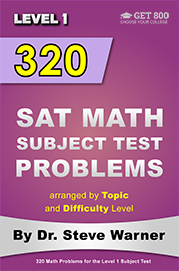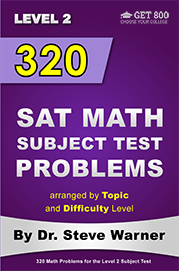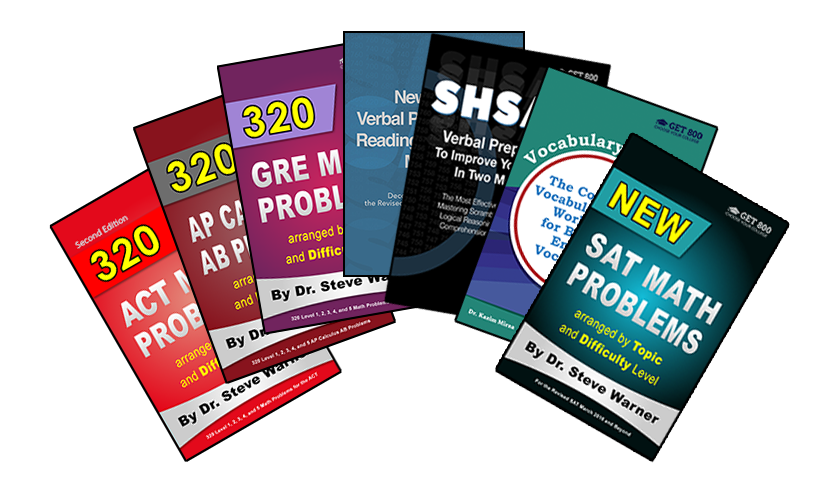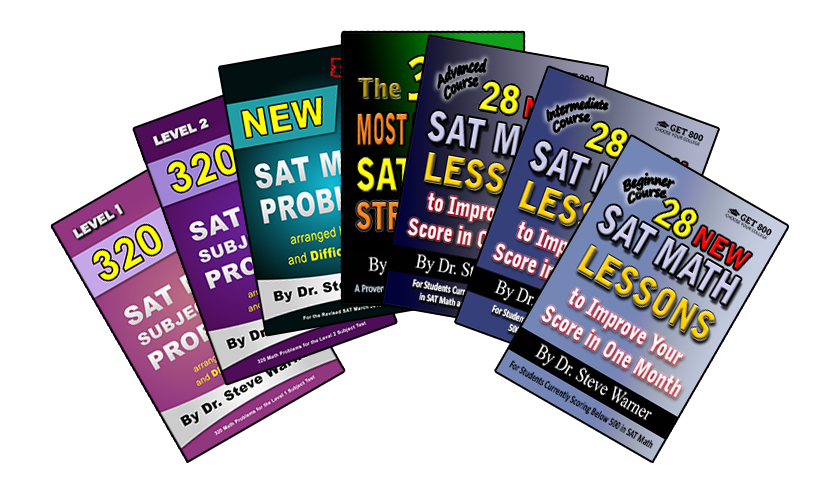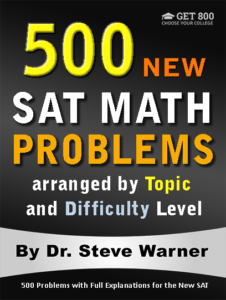
500 New SAT Math Problems
Just 19.99 on Amazon
Hi everyone! The latest edition of 500 New SAT Math Problems is now available in paperback from Amazon. This edition just has been modified from the previous edition to account for the changes on the Digital SAT.
The paperback is now on sale on Amazon for only $19.99. Note that once the sale ends (by the end of today), the price of this book will go up to $42.99.
The promotion has ended. Thanks to everyone who participated. The book is now available at its regular price here: 500 New SAT Math Problems
If you have any questions, feel free to contact me at steve@SATPrepGet800.com
Thank you all for your continued support!
A Trick For Free Two Day Shipping
I would like to finish this post with a little trick you can use to get free 2 day shipping on any of the books you decide to purchase without making any additional purchases. If you have never used Amazon Prime you can sign up for a free month using the following link.
Sign Up For Amazon Prime For Free
If you have already had a free trial of Amazon Prime you can simply open up a new Amazon account to get a new free trial. It just takes a few minutes! You will need to use a different email address than the one you usually use.
This next part is very important! After you finish your transaction, go to your Account, select “Manage my prime membership,” and turn off the recurring billing. This way in a month’s time Amazon will not start charging you for the service.
After shutting off the recurring billing you will still continue to receive the benefit of free 2 day shipping for one month. This means that as long as you use this new Amazon account for your purchases you can do all of your shopping on Amazon for the next month without having to worry about placing minimum orders to get free shipping.
Just be aware that certain products from outside sellers do not always qualify for free shipping, so please always check over your bill carefully before you check out.
Well I hope you decide to take advantage of this very special offer, or at the very least I hope you will benefit from my Amazon “free 2 day shipping trick.” Here is the link one more time:
Sign Up For Amazon Prime For Free
If you think your friends might be interested in this special offer, please share it with them on Facebook:
Thank you all for your continued support!
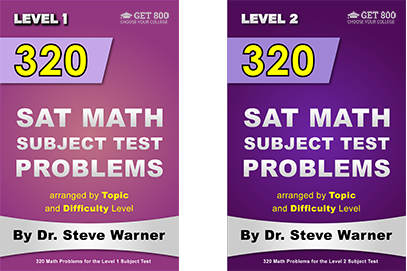 The Differences Between the SAT Math Subject Tests
The Differences Between the SAT Math Subject Tests

In addition to the SAT reasoning test (which most people simply refer to as the SAT), the College Board offers several SAT subject tests. Whether you should take any of these tests depends entirely upon the colleges you will be applying to. Some colleges require 2 or 3 SAT subject tests, while others may just recommend them.
There are two different subject tests for math: a Level 1 test and a Level 2 test. The question that I get asked about most frequently with regard to these tests is which is the best to take. In this article, I hope to provide you with enough information to make an informed decision.
 Test Length and Structure
Test Length and Structure

Both the Level 1 and Level 2 SAT math subject tests consist of 50 multiple choice questions. You are given an hour to complete each test. I like to think of each test as broken up into 5 pieces of 10 questions each, progressively increasing in difficulty level. In other words, I consider questions 1 through 10 to be difficulty level 1, questions 11 through 20 difficulty level 2, and so on, up through difficulty level 5 questions. Note that this is just a rough estimate – overall the questions do increase in difficulty as you work your way through the test, but easier questions can certainly occur after harder questions. In an attempt to avoid confusion, from now on I will use the word “Level” when talking about the Level 1 or 2 test, and the abbreviations L1, L2, L3, L4, and L5 for the difficulty levels of questions.
One really important thing to understand is that an L1 question on the Level 2 test is much harder than an L1 question on the Level 1 test. As an estimate, I like to add 2 “L’s” in translating from the Level 2 to the Level 1 test. In other words, an L1 question on the Level 2 test (questions 1-10) is about the same difficulty as an L3 question on the Level 1 test (questions 21-30). As another way to think of this, to translate the difficulty level of a problem from the Level 1 to the Level 2 test, simply subtract 20 from the question number. So for example, question 40 on the Level 1 test would probably appear as about question 20 on the Level 2 test, and question 15 on the Level 1 test wouldn’t appear on the Level 2 test because it would be too easy.
Scoring
Both SAT math subject tests are graded out of 800, but the way the score is determined is quite different for these two tests. The Level 2 test has a much, much more generous curve than the Level 1 test. If you get 2/3 of the answers correct on the Level 1 test, your final score will be about a 600. The same 2/3 ratio of correct answers on the Level 2 test will give you a final score of about 700. On many Level 2 tests, you can get up to 6 questions wrong and still get a perfect score of 800, whereas on the Level 1 test, you usually need to get every question correct for a perfect score.
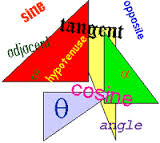
Mathematics Covered
The two SAT math subject tests cover many of the same topics, but there are differences. The Level 1 test covers topics from two years of algebra and one year of geometry (including a bit of trigonometry). The Level 2 test covers more advanced trigonometry and precalculus, and even throws in the occasional calculus problem. The following topics are covered on the Level 2 test, but not on the Level 1 test.
- Series
- Vectors
- Graphical Analysis of Complex Numbers
- Quadratic and Exponential Regression
- Standard Deviation
- Parametric Equations
- Recursive Equations
- Ellipses and Hyperbolas
- Polar Coordinates
- Distance in Three Dimensions
- Solid Geometry
- Radian Measure
- Graphs of Trig Functions
- Inverse Trig Functions
- Laws of Sines and Cosines
- Double Angle Formulas
One other big difference is that the Geometry on the Level 1 test is mostly coordinate and plane geometry, whereas there are only coordinate and solid geometry questions on the Level 2 test (although the solid geometry questions very often amount to understanding concepts in plane geometry).
Final Note
The best way to decide which test you should focus on is to take a practice test for both the Level 1 and Level 2 subject tests. I strongly recommend using official practice tests from the test makers themselves. Make sure to finish each test, and to score each one carefully. Remember that the Level 2 test has a much more generous curve. So it is possible to “feel” like you are performing much worse on the Level 2 test, and yet still wind up with a higher scaled score.
Once you decide which test you will focus on, make sure you take some time to prepare. If you’ve already prepared for SAT math, then about 20 minutes per day for another month should do the trick. You may want to use one of the books from my “320 Problems” series to prepare. Click on each of the following books to view the book’s Amazon page:
If you liked this article, please share it with your Facebook friends:
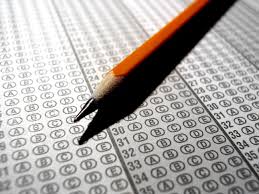 The Differences Between the ACT and the SAT
The Differences Between the ACT and the SAT

The ACT and SAT are both standardized tests that are used for college admissions. Students should be aware that they have a choice in which standardized test they choose to take. Years ago, the SAT was the more popular choice on the east and west coasts, and the ACT was more popular throughout the rest of the country. Last year, when the College Board debuted a new version of the SAT, these numbers changed significantly. In 2016, more than 2 million high schools students took the ACT and slightly less than a million-and-a-half students took the “new” SAT. But every student should realize that the final decision as to which test to focus on is entirely up to them. This article provides important information about the differences between the two tests so that you can make a more well-informed decision.
 Test Length and Structure
Test Length and Structure

The ACT consists of 5 sections. Only 4 of these sections must be completed. The fifth section – writing – is optional. For the required sections, there is a 45 minute english section, a 60 minute math section, a 35 minute reading section, and a 35 minute science section. You are given 40 minutes for the optional writing section. This gives a total required testing time of 45 + 60 + 35 + 35 = 175 minutes, or 2 hours and 55 minutes. With the optional writing section, the total testing time increases to 3 hours and 35 minutes.
The SAT is a longer test than the ACT. It also consists of 5 sections, one being optional (the essay). For the required sections, there is a 65 minute reading section, a 35 minute grammar section, a 25 minute math section where a calculator is not allowed, and a 55 minute math section where a calculator is allowed. You are given 50 minutes for the optional essay section. This gives a total required testing time of 65 + 35 + 25 + 55 = 180 minutes, or 3 hours. With the optional essay, the total testing time is 3 hours and 50 minutes.
On both the ACT and SAT, the essay is optional, and it is NOT factored into the final score. Many schools do however require the essay, so if you are not yet certain about all the schools you will be applying to you may want to take the essay as a precaution.
Scoring
The ACT is graded out of 36 points. The overall score is the average of the scores on each of the 4 required sections. Each of these is also graded out of 36 points.
The SAT is graded out of 1600 points. The overall score is the sum of the scores for verbal and math each consisting of a total of 800 points (note that the verbal score is made from both the reading and grammar sections, and the math score is made from the two math sections).
Conversion charts are easy to find for comparing ACT and SAT scores. For example, take a look here: ACT/SAT Conversion Chart (pages 7 and 15)
Pacing
The ACT requires a faster pace than the SAT to get through each section. Let’s look at math as an example, and assume that a student is pacing themselves to answer every single math question. The student has an average of 1 minute to complete each math question on the ACT, compared to an average of 1 minute and 15 seconds per question on the “no calculator” math section on the SAT, and an average of about 1 minute and 25 seconds per question on the “calculator allowed” math section of the SAT.
It should be noted that for many students it may be counterproductive to attempt every question on a standardized test, but this kind of advice lies outside the scope of this article.
 Science Section
Science Section

The ACT has a science section and the SAT does not. It should be noted that the science section is really more about reading comprehension and interpreting data found in charts, figures and tables. Very little knowledge of science is actually required (although it could be argued that students with a stronger science background are at an advantage here).
Free Response Questions
Both math sections on the SAT have free response questions, also known as “grid-ins.” In these questions the student must give a numerical answer without having any choices to choose from.
Calculator Policy
On the ACT you can use a calculator for every question. There are two math sections on the SAT, one where a calculator can be used, and one where a calculator cannot be used. Students that are very calculator dependent tend to have a lot of trouble with the “no calculator” SAT math section.
Difficulty versus Trickiness and Complexity in Math
ACT math problems tend to be more straightforward than SAT problems, whereas some SAT math problems are more complex and may take more time to answer. It is often much easier to understand ACT questions upon a first reading, whereas SAT questions tend to seem more confusing at first.
Many SAT math problems now go out of their way to model “real life” situations. In my opinion these types of questions tend to be more confusing and harder to read. The SAT also has more “multi-step” problems than the ACT (especially the more difficult problems that appear later in each section). You may have to complete 2, 3, or 4 distinct tasks to get to a solution.

Mathematics Covered
The ACT and SAT cover many of the same topics, but there are some differences. The following topics are covered on the ACT, but not on the SAT.
- Arithmetic
- Divisibility, Primes, GCD, LCM
- Sequences and Series (especially arithmetic and geometric sequences)
- Counting Problems
- Laws of Sines and Cosines
- Logarithms
Although there are no specific topics on the SAT that are not on the ACT, the SAT does place a heavier emphasis on Data Analysis, systems of equations and inequalities, and some more advanced precalculus concepts such as completing the square and divison of polynomials.
The ACT places a much heavier emphasis on Geometry than the SAT. Up to 50% of the ACT math questions can be Geometry and Trigonometry questions (much more Geometry than Trigonometry), whereas just a few math questions on the SAT will come from these topics.
Final Note
The best way to decide which test you should focus on is to take a practice test for both the ACT and the SAT. I strongly recommend using official practice tests from the testmakers themselves. Use a score comparison chart to compare your scores and you will see firsthand where your strengths lie.
Once you decide which test you will focus on make sure you take some time to prepare. I always recommend preparing for 10 to 20 minutes per day over a period of 3 to 4 months.
If you decide that you will be taking the SAT, I suggest you take a look at my “Get 800” collection of SAT math prep books, and if you decide that you will be taking the ACT, check out 320 ACT Math Problems arranged by Topic and Difficulty Level. Click the picture below for details.
If you liked this article, please share it with your Facebook friends:

Turn Wrong Answers Into Right Answers
On Standardized Tests
Today I want to discuss a common mistake that students make which leads to bad preparation. The type of mistake I am about describe is especially common during preparation for standardized tests such as the ACT, SAT and GRE.
Although many problems on standardized tests can be very difficult to solve, it is usually not very hard to understand the solutions. After getting a problem wrong, a good student will go over the solution until they understand it completely. Very often, however, the same student will misinterpret understanding the solution as being able to reproduce the solution on their own.
If after a student gets a question wrong I explain the correct way to do it and they understand my explanation, then more than likely if I ask them to solve the question 5 minutes later they will be able to do so. But it is important to realize that this does not mean that they will be able to solve a similar question (or even the exact same question) two months later during their SAT.
Understanding a solution and being able to reproduce it using short term memory does not necessarily lead to long term retention.
So what is the answer? How does a student make sure that they do not make the same mistake on their actual exam that they had made during their preparation?
The answer is quite simple.
During preparation, anytime you get a question wrong mark it off. You should have a special mark that is easy to see and recognize. Students of mine use stars, spirals or even sad faces.

Yes, the marks above were created in MS Paint! But I’m sure, you get the idea…
It is very important to mark off every single question you have gotten wrong regardless of the reason. Even if the only reason you got it wrong was because you accidentally hit a wrong button in your calculator, or even if you got it wrong because you just misread one of the numbers in the problem – mark it off anyway! It is very easy to say “oh that was just a silly mistake – I know how to do this,” and then to never look at that problem again. This is a huge mistake. Let me repeat this one more time. Mark off EVERY question you get wrong. Every question! Not just the ones you do not understand. EVERY SINGLE ONE!
You must reattempt each question you get wrong at least four days later. Do not reattempt the problem the next day, or the day after that. If you wait only one or two days you may be getting the problem correct for the wrong reason. The question is too fresh in your mind. You need time to forget how you solved it. This way you can be sure that you understand how to solve the problem, as opposed to simply recalling the solution.
If you get the problem correct you can “unmark” it and remove it from the list of problems you need to redo. If you get it wrong again, then leave it marked off and reattempt it again at least four days later. You need to keep reattempting each problem you get wrong with at least four days between attempts. You should only stop reattempting a problem once you get it completely correct on your own without recalling exactly how the problem was solved. Only then can you know for certain that you have internalized the technique necessary to solve that problem.
If you follow the advice I have given here, then every time you get a problem right that you had previously gotten wrong, you will be one step closer to a perfect score on the SAT, ACT, GRE, or whichever exam you are preparing for.
I want you to treat this message in the same way as I recommend you treat a question you answer incorrectly. Come back to this article in four days time. Reread it. Internalize it. I am certain you will benefit from the information given here if you make it a part of your long term memory..
And if if you would like lots of practice problems I suggest you take a look at the Get 800 collection of test prep books. Click on the image below for more information about these books.

How Many Questions Should You Be Attempting
In Each ACT Math Section?
Yesterday I explained why most students should not be attempting every math question on the SAT, and I gave a table displaying how many questions they should be answering based upon their current PSAT or SAT math score. To see that information, follow this link:
How Many Questions Should You Be Attempting In Each SAT Math Section
Today I will give you similar information for the ACT. As for the SAT, many students can increase their ACT math score by decreasing the number of questions they attempt to solve. Your goal when taking the ACT should be to maximize your score, and not to solve every single problem. If you are going for a perfect 36, then of course you will need to solve every problem, but for most of us, we won’t have to do that.
There is only one 60 question math section on the ACT. You should first make sure that you know what you got on your last official ACT practice test or actual ACT (whichever you took last). What follows is a general goal you should go for when taking the exam.
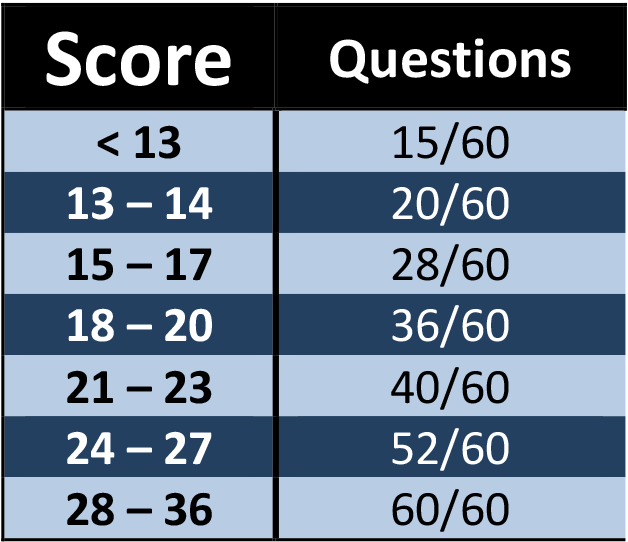
For example, a student with a current score of 22 should attempt 40 of the 60 questions. This could be the first 40 questions, but it is okay to skip a few here and there and try some that come a little later instead.
This is just a general guideline. Of course it can be fine tuned. As a simple example, if you are particularly strong at algebra problems, but very weak at geometry problems, then you may want to try every algebra problem no matter where it appears, and you may want to reduce the number of geometry problems you attempt.
Important note: There is no guessing penalty on the ACT. You should therefore fill in an answer for every question, even those questions that you do not attempt to solve. Simply take guesses for those last questions before time is up.
If you are currently preparing for the ACT, you may want to take a look at my series of ACT math books.
Hello everyone.
Today I would like to go over the differences between the ACT and the SAT. I’ve already written a blog post on this subject here: The Differences Between the ACT and SAT
I have also just uploaded a video with this information to my YouTube channel. You can visit the YouTube page here: The Differences Between the ACT and SAT – Video
The video is also embedded below for your convenience:
 The ACT and the SAT
The ACT and the SAT

The ACT and SAT are both standardized tests that are used for college admissions. Students should be aware that they have a choice in which standardized test they choose to take. As of 2014, the SAT seems to be the more popular choice on the east and west coasts, and the ACT is more popular throughout the rest of the country (with a few exceptions). But every student should realize that the final decision as to which test to focus on is entirely up to them. This article provides important information about the differences between the two tests so that you can make a more well-informed decision.
 Test Length and Structure
Test Length and Structure
The ACT consists of 5 sections. Only 4 of these sections must be completed. The fifth section – writing – is optional. For the required sections, there is a 45 minute english section, a 60 minute math section, a 35 minute reading section, and a 35 minute science section. You are given 30 minutes for the optional writing section. This gives a total required testing time of 45 + 60 + 35 + 35 = 175 minutes, or 2 hours and 55 minutes. With the optional writing section, the total testing time increases to 3 hours and 25 minutes.
The SAT is a longer test than the ACT. It consists of 10 sections, all required. There is one 25 minute essay, one 25 minute writing section, one 10 minute writing section, two 25 minute reading sections, one 20 minute reading section, two 25 minute math sections, one 20 minute math section, and one 25 minute experimental section which may be reading or math. This gives a total testing time of 7(25) + 2(20) + 10 = 225 minutes, or 3 hours and 45 minutes. If we add in the three 5 minute breaks, we get a total time of 4 hours from the beginning to the end of the test.
Note that on the SAT the essay is given at the beginning of the test, it must be completed, and it is factored into the final score.
On the ACT the essay is given at the end of the test, it is optional, and it is NOT factored into the final score.
Scoring
The ACT is graded out of 36 points. The overall score is the average of the scores on each of the 4 required sections. Each of these is also graded out of 36 points.
The SAT is graded out of 2400 points. The overall score is the sum of the scores for reading, writing and math each consisting of a total of 800 points.

Conversion charts are easy to find for comparing ACT and SAT scores. For example, take a look here: ACT/SAT Conversion Chart
Pacing
The ACT requires a faster pace than the SAT to get through each section. Let’s look at math as an example, and assume that a student is pacing themselves to answer every single math question. The student has an average of 1 minute to complete each math question on the ACT, compared to an average of 1 minute and 15 seconds per question on the multiple choice math sections on the SAT.
It should be noted that for many students it may be counterproductive to attempt every question on a standardized test, but this kind of advice lies outside the scope of this article.
 Science Section
Science Section

The ACT has a science section and the SAT does not. It should be noted that the science section is really more about reading comprehension and interpreting data found in charts, figures and tables. Very little knowledge of science is actually required (although it could be argued that students with a stronger science background are at an advantage here).
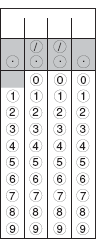 Free Response Questions
Free Response Questions
One of the math sections on the SAT has 10 free response questions, also known as “grid-ins.” In these questions the student must give a numerical answer without having any choices to choose from.
Guessing Penalty
The SAT penalizes students for guessing multiple choice questions incorrectly. One quarter of a point is deducted from the student’s raw score for each wrong answer. The final raw score is then rounded to the nearest integer before it is converted to a scaled score. Note that only multiple choice questions have a guessing penalty. There is no penalty for free response questions.
Difficulty versus Trickiness in Math
The ACT tests a few math topics that are more advanced than those found on the SAT, but SAT questions tend to be much trickier. It is often much easier to understand ACT questions upon a first reading, whereas SAT questions tend to seem more confusing at first.
ACT problems tend to be more straightforward, and may be easier for students with stronger algebra skills. On the SAT algebra and messy computations can usually be avoided by “outside the box” thinking.
 Mathematics Covered
Mathematics Covered

The ACT covers a few more advanced math topics that never appear on the SAT.
- Basic Trigonometry
- Laws of Sines and Cosines
- Logarithms
In addition, the ACT places a slightly higher emphasis on arithmetic and geometric sequences, complex numbers, rational functions, and basic algebra skills.
Final Note
The best way to decide which test you should focus on is to take a practice test for both the ACT and the SAT. I strongly recommend using official practice tests from the testmakers themselves, preferably an old actual exam from each. Use a score comparison chart to compare your scores and you will see firsthand where your strengths lie.
Once you decide which test you will focus on make sure you take some time to prepare. I always recommend preparing for 10 to 20 minutes per day over a period of 3 to 4 months.
If you decide that you will be taking the SAT, I suggest you take a look at my “Get 800” collection of SAT math prep books, and if you decide that you will be taking the ACT, check out the “ACT Prep Red Book.” Click the picture below for details.
If you liked this article, please share it with your Facebook friends:

